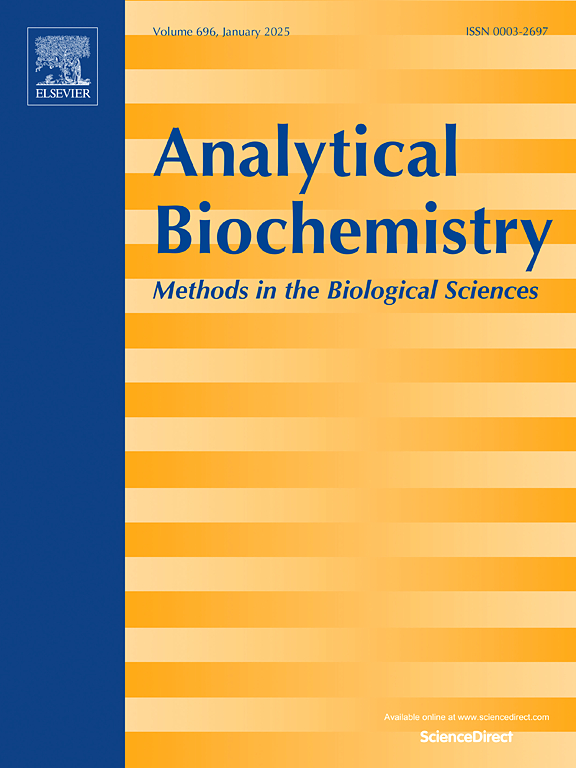Next-generation electrochemical biosensors for acrylamide: Progress, challenges, and opportunities
IF 2.6
4区 生物学
Q2 BIOCHEMICAL RESEARCH METHODS
引用次数: 0
Abstract
Acrylamide is a hazardous substance present in heat-processed food products and industrial wastewater. It is carcinogenic and neurotoxic and therefore emphasises the importance of monitoring its levels and the need for sensitive and accurate detection techniques. Electrochemical biosensing has emerged as a potential analytical method for detecting acrylamide. This article provides a comprehensive overview of the most recent developments in electrochemical biosensing methods, including amperometric, potentiometric, and impedimetric biosensors for acrylamide detection. The creation and use of novel biorecognition components, such as enzymes, antibodies, and molecularly imprinted polymers that enhance the sensitivity and specificity of acrylamide monitoring, are given special attention. Incorporating nanomaterials such as carbon-based nanomaterials and metallic nanoparticles was investigated for its potential to improve the sensors' electrochemical characteristics and overall efficacy. The potential of electrochemical biosensors for acrylamide detection is further illustrated, showcasing their effectiveness in a range of matrices in different food products. This review aims to inform researchers about the latest technological developments, trends, and future directions in electrochemical biosensing for acrylamide detection. The study highlights the significance of ongoing research and cooperation in creating efficient biosensing systems to protect public health and the environment by thoroughly examining current technology and pointing out areas for improvement.

下一代丙烯酰胺电化学生物传感器:进展、挑战和机遇。
丙烯酰胺是一种存在于热加工食品和工业废水中的有害物质。它具有致癌性和神经毒性,因此强调了监测其水平的重要性以及对敏感和准确检测技术的需求。电化学生物传感已成为一种有潜力的检测丙烯酰胺的分析方法。本文全面概述了电化学生物传感方法的最新发展,包括用于丙烯酰胺检测的安培、电位和阻抗生物传感器。新的生物识别成分的创造和使用,如酶、抗体和分子印迹聚合物,提高了丙烯酰胺监测的敏感性和特异性,得到了特别的关注。研究了碳基纳米材料和金属纳米颗粒等纳米材料对传感器电化学性能和综合效能的改善作用。电化学生物传感器用于丙烯酰胺检测的潜力进一步说明,展示了它们在不同食品中的一系列基质中的有效性。本文综述了电化学生物传感检测丙烯酰胺的最新技术进展、趋势和未来发展方向。该研究强调了正在进行的研究和合作的重要性,通过彻底检查现有技术和指出需要改进的领域,创造有效的生物传感系统,以保护公众健康和环境。
本文章由计算机程序翻译,如有差异,请以英文原文为准。
求助全文
约1分钟内获得全文
求助全文
来源期刊

Analytical biochemistry
生物-分析化学
CiteScore
5.70
自引率
0.00%
发文量
283
审稿时长
44 days
期刊介绍:
The journal''s title Analytical Biochemistry: Methods in the Biological Sciences declares its broad scope: methods for the basic biological sciences that include biochemistry, molecular genetics, cell biology, proteomics, immunology, bioinformatics and wherever the frontiers of research take the field.
The emphasis is on methods from the strictly analytical to the more preparative that would include novel approaches to protein purification as well as improvements in cell and organ culture. The actual techniques are equally inclusive ranging from aptamers to zymology.
The journal has been particularly active in:
-Analytical techniques for biological molecules-
Aptamer selection and utilization-
Biosensors-
Chromatography-
Cloning, sequencing and mutagenesis-
Electrochemical methods-
Electrophoresis-
Enzyme characterization methods-
Immunological approaches-
Mass spectrometry of proteins and nucleic acids-
Metabolomics-
Nano level techniques-
Optical spectroscopy in all its forms.
The journal is reluctant to include most drug and strictly clinical studies as there are more suitable publication platforms for these types of papers.
 求助内容:
求助内容: 应助结果提醒方式:
应助结果提醒方式:


